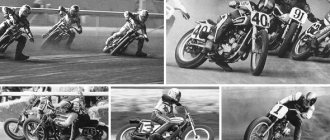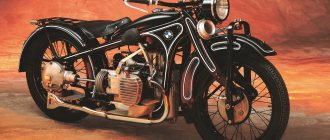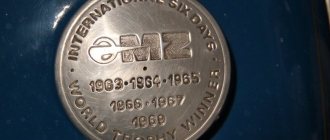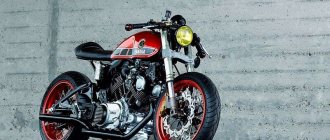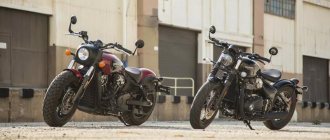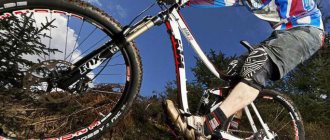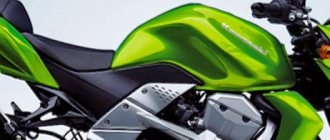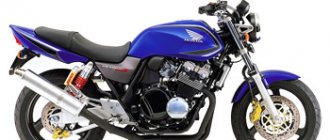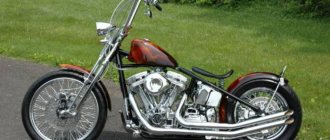Its history begins in 1900. George Hendee was involved in the production of racing bicycles. The development and production of racing bicycles was not only a business for him, but a way of life. George Hendee spent his youth racing on cycle tracks, where he won prizes more than once. The designer of Oscar Hedstrom sought to attract the attention of cyclists to a motorcycle of his own design, to participate in the increasingly popular “vacuum bag” race, in which a cyclist races behind a heavy car, while gaining incredible speed. Incredibly, George Hendee himself became interested in his idea; the businessman and athlete made a counter offer to Oscar to organize a joint venture for the development and production of motorcycles. In the city of Springfield, Massachusetts (USA), the partners decided to name their development “Indian” in translation “Indian”. And so the history of Indian motorcycles opens with the first model released in 1901.
The motorcycle was technically advanced for that time. Initially, the Hedstrom designer abandoned the standard bicycle frame and developed a special tubular structure, with a separate place for installing dry batteries for ignition. The four-stroke 260 cc engine, the new design also served as a seat frame, the motorcycle’s power was only 1.75 horses. First, a gas tank was installed in the rear fender. The rear wheel drive, unlike its competitors using a belt, designer Oscar Hedstrom, decided to use a chain drive like on a bicycle. The first year brought the sale of only one motorcycle, and the next year they sold 142 devices. And this is an indicator of sales of large, global motorcycle manufacturers of that time.
The next updated motorcycle model in 1904 increased its displacement and reached 310 cm3 with a power of 2.25 hp. In 1905, the front fork design became spring-loaded. But the main feature of the motorcycle is the gas handle, which has moved to the left side. Sales during the year reached 1,000 motorcycles.
The history of Indian motorcycles became acquainted with the V-shaped design of a two-cylinder engine in 1907. The V-shaped model, on which a 633-kop engine was installed, produced power of 3.5 hp. They also developed a racing 1000 cc model of the motorcycle. Since 1908, all models have been equipped with the new magneto ignition.
In addition, the modernization also affected the power component; two options were proposed - with automatic and forced exhaust valves. The power of the engines also increased: the single-cylinder 442 cc reached 3.5 horses, and the two-cylinder 5.5 hp.
Motorcycles received a new, tubular, closed frame only in 1909. The gas tank was moved forward. It is worth noting that for single-cylinder motorcycles, the backward angle of the cylinder has been preserved. “Two-cylinder” with a working volume of up to 1000 cm3, the power of which has increased slightly to 7 hp. A drive with a belt drive could be made to order.
Motorcycle models of 1910 with the famous front fork with a unique, elliptical spring that became the calling card of the Indian, which lasted without significant changes until the 40s. The designers provided the opportunity to choose a model with a new gearbox with clutch. The history of Indian motorcycles also includes sports records. For the 1911 races, Oscar Hedstrom developed a new racing motorcycle with a two-cylinder, V-shaped power unit, the volume of which was 1000 cm3. The sports model of the motorcycle set an American speed record. After this, he decided to take part in the famous “Tourist Trophy” race in Britain, where motorcycles with 585 cc four-valve engines took part, and two-cylinder vehicles with 600 cm3 power units were allowed to participate in the “Senior” class. American-made motorcycles absolutely crushed all the participants and won all the prizes.
Since 1913, the company's management has completely concentrated its production on V-twin models, and they accounted for 90% of the total. The most advanced 998 cc motorcycle of the time was made in 1914 by the Hendee Special, equipped with a full set of electrical equipment including a headlight, electric starter and signal. We are not talking about the quality of batteries here; the century of the Hendee Special motorcycle was not long. In 1915, Oscar Hedstrom launched a three-speed version of the gearbox into mass production. In order to increase production capacity (although already in 1914 it produced more than 25 thousand motorcycles - and reserved for itself a leading position in the world motorcycle production) - it issues shares. And as it sometimes happens, the founding fathers lose a controlling stake in the management of the company. And in 1915, Hendee and Hedstrom realized that they were no longer the sole owners of their brainchild, retiring. A rejuvenated management team consisting of local financial tycoons, who took a controlling stake in the shares, invites Charles Gustafson (Charles Gustafson), working at .
Charles Gustafson put the development of a new engine at the forefront. And in 1918 he released a new heavy-duty motorcycle, Powerplus (Powerplas). The Powerplus motorcycle was equipped with a two-cylinder, V-shaped, 998 cm3, lower valve 18-horsepower engine, with fantastic power of that time. Next, a single-cylinder version of its older brother K Featherweight (translated as Lightweight) is being developed; based on the name, this is a lightweight motorcycle made with an English accent. Equipped with a two-stroke engine, the displacement of which reached -220 cm3, and the power - 2.5 hp. Lightweight frame, with rigid rear suspension and primitive front fork. The option turned out to be extremely unsuccessful, unreliable, and production was soon discontinued. It is being replaced by a new product with a two-cylinder opposed, lower-valve power unit with a volume of 257 cm3 and a power of 4 hp. Power unit with forward and backward cylinders, similar to the British Douglas. The first models were produced with a simplified fork; soon it was decided to equip it with our own “Indiana” fork, equipped with a longitudinal spring. During the First World War in 1917. managed to bite a large piece, an order was received for the army for 20 thousand Powerplus motorcycles, which were sent overseas. The powerful 1000 cc motorcycle manufactured by Indian did not give up its leading position, unlike its “younger” brothers, which were practically not perceived by Americans. The situation changed radically with the release of the new Scout, developed by Charles Franklin. A two-cylinder, V - 606 kb Scout motorcycle with a lower valve engine, the power of which reached 11 horses, the engine was attached to a tubular type frame. The device was equipped with a three-speed gearbox. The front fork acquires the status of “traditional”, having a longitudinal spring. However, the device did not have legendary reliability, and this was due to helical gears in the transmission, as well as the clutch system. Surprisingly, this did not stop him from winning a world record in 24-hour races in 1920. The Scout motorcycle, having good handling and enviable dynamics, covered 1,793 km. The history of Indian motorcycles in 1920 records a significant event when it was decided that all motorcycle models must be equipped with front wheel brakes. And the “Chief” and “Big Chief” motorcycles were combined and installed a powerful 1206 cc power unit. In 1922, a new model, the “Chief,” was introduced, replacing the Scout. The Chief had an engine with a large volume of 998 cm3; the base was slightly increased from 1,384 to 1,537 mm. A year later, a 1206 cc classmate Big Chief was released whose power reached 22 hp. In the history of Indian motorcycles there were also unsuccessful developments. These include the single-cylinder Prince, released in 1925, with a 348 cc engine with a power of 6 hp, made in a purely English style. This device did not leave a bright spot in the history of Indian, since it did not acquire even a small share of the popularity of V-shaped models with two cylinders. It is worth noting that competitor Harley-Davidson was developing similar models. And in order not to start price wars and not go broke due to competition, they secretly entered into an agreement to set equivalent prices, according to similar models. 1927 was a successful year; this year the company acquired the right to produce “ACE” devices, powerful 30-horsepower monsters with four cylinders, the working volume of which was 1265 cm3, with a crankshaft on three supports. They decided to launch the release in the state of Massachusetts. Accordingly, all the necessary equipment was delivered and personnel was selected. Initially, “ACE” was produced in its original version, with a three-speed gearbox with a chain drive, the basis was a tubular frame and a rigid rear suspension.. In the next season of 1928, the Indian developers released a modernized model of the ACE motorcycle with the index “401” on which, a “traditional” front fork is already installed, like most Indian motorcycles. In 1929, the deeply redesigned Indian 402 was released, based on a duplex frame. And in 1927, to the 600 cc. The Scout model adds a more powerful 745 cc, 18 horsepower classmate. A year later, the entire 101 Scout family acquires an extended wheelbase of 1,451 mm. and a modernized frame. In America in the 20s, city residents began to switch to cars, and motorcycle manufacturers began to suffer losses. was no exception; it tried to compensate for its losses in motorcycle production and set a course for diversifying production. She began to try her hand at making automobile shock absorbers, boat engines, and even producing household appliances. But this attempt was not crowned with success in 1929, and the period of the “Great Depression” became the owner of E. Paul DuPont (Paul DuPont) from the clan of representatives of the chemical corporation. The new owner in 1932 modernizes and significantly expands the model line and improves build quality. The ignition magneto is replaced by a battery. Frames with powerful front forks are getting longer. Unfortunately, heavier units became less agile and more expensive, which could not generate admiration among consumers. One of the available motorcycles was the Scout Pony, a V-shaped, two-cylinder, 492 cc, whose power reached 12 hp, later renamed the Junior Scout. Since 1934, the “burn-out” lubricant was gradually replaced by a more efficient circulation system - the “dry sump” system. The first such motorcycle was Motoplane (Motoplane) with a displacement of 745 cm3, which became a symbiosis combining the engine from Scout and the chassis from Scout Pony. Unfortunately, the frame turned out to be rather weak for this powerful engine. Soon the unsuccessful Motoplane is replaced by a more powerful Sport Scout; a forced, 745 cc engine with a power of 25 hp is installed on it. The tubular frame was reinforced with bolts. And a parallelogram fork was installed forward. The gearbox housing was docked to the power unit, it was connected by special. plates and three-row chain transmission. Soon, in 1934, the gear drive on the “Chief” was replaced by a three-row “non-killable” chain drive. A mysterious experiment in the history of Indian motorcycles was carried out in 1936. Tests were carried out on a four-cylinder power unit. The location of the valves was radically reversed: the intake valves were placed at the bottom, and the exhaust valves were located at the bottom. The developers expected to increase engine power, but customer reviews do not confirm this. Two years later, manufacturers returned to the classic valve arrangement system. The later classic wing skirts, which covered a significant part of the wheel, covered the entire Indian model range by 1940. At the same time, a spark plug rear suspension system began to be installed on Chief motorcycles. It was planned to equip all four-cylinder engines with the same rear suspensions, but this idea was postponed because... all production facilities were focused on military needs. And in 1940, the assembly line started producing the army model “Indian 741B”. It was a hybrid model with a 492 cc engine producing 15 hp, and the chassis was borrowed from the Sport Scout motorcycle. But the American military preferred Harley-Davidson motorcycles, so almost all Indian 741B motorcycles were sent to the allies. There were also deliveries to Canada of the 745 cc model "640B" which could use a sidecar. But the German models of BMW motorcycles delighted American soldiers, and the command placed an order for their companies Harley-Davidson and Indian for similar motorcycles. The “Harley-Davidson” version is a conscientious reworking of the “R71”, and the “Indian” version is a complete new product, with two cylinders with a total volume of 745 cm3, with an engine power of 25 hp. The Indian 841 motorcycle was not very different from the Sport Scout, the only difference being that the engine was turned 90 degrees. It was equipped with a four-speed gearbox with a cardan drive. Powerful, duplex frame, with “Indiana” fork and spark plug suspension at the rear. For testing under the contract, the developers of Harley-Davidson and Indian motorcycles were supposed to supply 1000 copies each, but the contract was not fulfilled because The military decided that the best solution for all problems was Jeeps. There were, however, also experiments with light motorcycle models specifically for paratroopers. At the end of the war, the Indian company continued to produce one of its successful developments, “Chief,” the modernization affected only the front fork and was replaced with a parallelogram one. Over time, Paul DuPont, who bought the company, loses interest in it and begins to look for a new owner. A good candidate might be industrialist Ralph W. Rogers. Rolf had been planning to get into motorcycle production for a long time, and prepared a project to create a new line of British-type motorcycles, the author of which was G. Briggs Weaver. Worked before the war in a design bureau.
The debut of the new Briggs Weaver model series saw the light of day in 1948. The new line included only two models: the 1st with one cylinder with a volume of 218 cm3, the power of which reached 12.5 horses. “Arrow” - translated as “Stela”; 2nd with two “Scout” cylinders with a displacement of 436 cm3 and a power of 22 hp, with an overhead valve power unit. The engine design had vertical cylinders and a four-speed gearbox.
The new models were based on tubular frames with Indiana front forks. Their rear suspensions were different “Arrow”, for example with a rigid suspension, and “Scout” was equipped with a spark plug. But these motorcycles did not have the character of American units and were not to the “taste” of local motorcyclists. Unlike traditional Indian motorcycles, these models were too simple, lacked “V-magic” and were underpowered. The history of Indian motorcycles under the leadership of Ralph W. Rogers in the 40s turns out to be a difficult financial situation, which leads to rash decisions, which has an extremely negative impact on the image of the corporation. In its own branded trading pavilions, it offers for sale light motorcycles of the Czech production of the ChZ-et brand, but produced by the American company. And when the British government decided to devalue its pound by 30%, excellent and very inexpensive English motorcycle models poured into America. In this difficult situation, Rogers takes the worst possible option. Rogers R. enters into a division agreement with British businessman John Drockhouse. The commercial part with the entire sales network is taken over by Jono Brockhouse, who began the hunt for American motorcyclists with English imports. By the end of 1950, the native “Indian” models underwent the last deep processing, the “Arrow” model was removed from the production line, the “Scout” gave way to the “Warrior” motorcycle, translated as a fighter, equipped with a 498-cc, 29-horsepower power unit of its own design. . On the “Chief” motorcycle, the engine is changed to a 1311 cc engine with 50 hp. The gas handle moves from the left to the right side.
Unfortunately, this did not solve all the problems. The number of motorcycles produced drops significantly from tens of thousands to several hundred copies. 1952 was the final year for Warrior motorcycles. And 1953 becomes the last year for the Indian Chief,” the final push for the “Chief” motorcycle is the release of the last 50 copies of a special order for New York police officers.
is on the verge of extinction, and at this stage it is picked up by. And under its banner, it began to offer British-made Royal Enfield motorcycle models to American buyers; in the mid-50s, they also began selling Matchless motorcycles. Since 1960, the entire trading infrastructure was transferred to the manufacturer Match-loess, part of the AMC concern, and the brand name was no longer used. The next stage in the history of Indian motorcycles begins under the leadership of the successful publisher Floyd Clymer, who in the recent past was actively involved in the sale of Indian motorcycles. And in the 60s he decided to become the successor to the right to use the name of a dying brand. And together with the talented developers Friedel Munch from Germany, he began designing a new model, the “Scout” scooter. The debut of which took place in 1967, “Scout” was truly seriously modernized. The design was a durable, duplex tubular frame, with a powerful V-shaped, 745 cc, lower valve engine and European chassis. And Floyd Clymer was determined to revive history, and while motorcyclists did not completely forget the Indian brand, he decided to buy Italian light motorcycles “IItaljet” for cross-country racing during the period of establishing new production facilities, and offer them from “Indian”. In addition, an agreement was concluded with the talented designer Leopold Tartarini to develop a new chassis taking into account the characteristics of powerful and heavy English engines. In 1969 and 70 alone, over 200 motorcycles with the “Indian” logo were sold in England and America, the bulk of which were single-cylinder Velocette-500 motorcycles and a couple of dozen two-cylinder motorcycles with a volume of 736 cm3 with English engines manufactured by Royal Enfield.
History suffers another great loss, Floyd Clymer dies, and all revival efforts fail. The next person to acquire all rights from Clymer's widow was Alan Newman, who continued to supply imported motorcycles. And in addition, also under “Indian”, he began to offer light Taiwanese motorcycles with a small engine capacity (50-170 cm3). However, this idea also ends sadly, in 1975 Alan Newman went bankrupt, now everything becomes the legal successor. The name changes slightly and becomes Indian Four, which continues to sell Taiwanese-made motorcycles and four-stroke scooters between 1977 and 1981.
The first years of innovation
Indian is considered the first major player to launch motorcycle production back in 1901, 2 years before Harley-Davidson. Indian begins with racing driver Oscar Hedström and self-taught engineer George Hendy developing motorcycles that would later become technically advanced for their time. Based in Springfield, Indian would be the first company to create time after time innovative machines : a motorcycle with a twin-cylinder V-twin engine, a 2-speed transmission, the first electric start, electric lights and much more. Indian dominated the motorcycle market and also set racing records.
intense competition between Indian and Harley-Davidson in the first half of the 20th century , so company-sponsored riders were expected to remain committed to the company further. Legendary Indian racers such as Bobby Hill, Bill Tuman, Ernie Beckman (all members of the famous Indian Wrecking Crew of the 1940s and 50s), as well as Ed Kretz and Burt Monroe made the Indian brand and the word “success” synonymous.
Racer Ervin "Cannonball" Baker also brought fame to Indian with his record breaking: in 1914 he drove from San Diego to the East Coast in 11 days, 12 hours, 10 minutes, and in 1915 Baker set the fastest time of three and a half days in a race from Canada to Mexico via California. One of the most famous Indian models is the heavy-duty Powerplus , equipped with a two-cylinder V-twin engine. However, in 1917 Indian switched to producing motorcycles for the war effort, and resources for commercial production became increasingly scarce. Despite its success in the early years, Indian had its share of setbacks as sales declined in the US while exports to the UK increased.
When you take a trip back in time and look at some of the most collectible Indian motorcycles, like the vintage Indian Four, you begin to understand how these motorcycles have evolved over time, and now we're salivating over their latest lineup, including the stunning Indian Chief 2022.
Dive into the true story of the Indian Motorcycle Company's stunning designs, rise and fall.
A Brief History of Indian Motorcycle Company
The true story of the Indian Motorcycle Company is a roller coaster ride. Since its founding in 1901, the brand has failed four times in various forms. Throughout the second half of the 20th century, a number of companies and individuals attempted to revive Indian.
The reasons why so many different people tried to bring Indian back can be summed up in one word: legacy. Indian Motorcycles is one of America's most iconic motorcycle brands. The original Indian Motorcycle Company was founded 119 years ago. As one of the first motorcycle companies, they were responsible for some of the earliest advances in motorcycle technology and several impressive early motorcycle speed records.
In 1897, George M. Hendy created a bicycle company. The most popular model, Indian, eventually became the company name. In 1901, Hendy hired Oskar Hedström to create a gasoline-powered bicycle that could compete in bicycle racing. Following the success and hype surrounding this first machine, the company opened a plant in Massachusetts and began mass production of motorcycles. In their first year in business, an Indian motorcycle racer won a race from Boston to New York.
In 1906, a pair of racers drove from San Francisco to New York in a record 31.5 days. In the 1910s, Indian motorcycles were redesigned with a modern suspension system, the first electric start on a motorcycle, and a 1000 cc engine. cm.
1921 Indian Scout
All these updates helped the company break even more speed and endurance records. In 1914, Erwin "Cannonball" Baker set a new coast-to-coast travel record of 11.5 days, 20 days faster than their trip to New York just eight years earlier. During World Wars I and II, Indian produced thousands of military motorcycles to support the Allied war effort.
Attempts to revive the company
After bankruptcy in 1953, two different groups tried to use the trademark to sell imported motorcycles. The first, Brockhouse Engineering, bought the rights to the Indian name and sold imported Royal Enfield models under the Indian name. But these imported bikes did not perform as well as the original motorcycles. As a result, the company sold only 7,000 units and closed around 1960.
In 1963, motorcycle racer and magazine writer Floyd Clymer began working to revive the brand. When Clymer died in 1970, his lawyer took over the project, selling Taiwanese and Italian models with Indian badges. But they didn't sell very well, and business stopped in 1977. At the same time, Bert Munro, a 68-year-old native of New Zealand, set a new record for the fastest streamlined motorcycle under 1000cc. cm on his modified 1920 Indian Scout.
1950 Indian Chief
In 1998, nine companies joined forces to create IMCA, which sold Indian-branded motorcycles made in America. Unfortunately, this company went bankrupt in 2003. In 2008, a private equity firm bought all of the company's assets, built a new plant in North Carolina, and sold it all to Polaris in 2011. Although the Native American motorcycles have not set any new speed records recently, owners can take pride in the fact that the models are made in the USA and that they are a part of motorcycle history.
Polaris introduced the now iconic 49-degree Thunder Stroke III V-Twin engine in 2013, displacing 111 cubic inches (1,811 cc). It provided 160 Nm of torque at a maximum engine speed of 5,500 rpm. The air-cooled engine with integrated oil cooling features down-firing exhaust pipes with a left side air intake, as well as finned heads and parallel pushrods.
Let's take a look at some of the coolest Indian motorcycles.
Indian Roadmaster
Indian Roadmaster 2020
We first saw the Indian Roadmaster in 2014, a Thunderstroke 111 powered touring bike that produces 161 Nm of torque. The bike included features such as remote-locking saddlebags and a powered Horizon windshield, while weighing 420kg on a full tank.
The 2021 range includes the latest Roadmaster with the Thunderstroke 116 V-Twin engine and 140 liters of cargo space. It's what we crave when we want to hit the road on a long adventure, not to mention all the perks we expect from a high-end touring bike, like keyless ignition, cruise control, heated seats and powerful premium speakers.
Indian Springfield
Indian Springfield 2016
Indian Springfield first caught our attention in 2021. Classified as a "baggy" style bike, but with some touring bike elements, with a redesigned chassis "designed to handle a wider load range" with a dry weight of 370kg.
The 2021 Indian Springfield offers a lightweight aluminum frame designed to improve handling, not to mention three riding modes: Tour, Standard and Sport. Let's not forget what gives this beast power; amazing Thunderstroke 116!
Indian Challenger Dark Horse
The 2021 Indian Challenger Dark Horse delivers a desirable 122 horsepower and an enticing 173 lb-ft of torque from the V-Twin while offering a dominant presence on the road.
But the 2021 Indian Challenger Dark Horse remains to be seen. First, it comes with amazing features like Dynamic Traction Control, Bosch 6-axis IMU, Brembo braking, hydraulically adjustable Fox rear shocks, 7-inch Ride Command screen, and a great audio system.
Indian Springfield Dark Horse Jack Daniel's Limited Edition
Jack Daniel's may be the best whiskey choice for many, but it was also the inspiration for one of Indian's amazing motorcycles. Jack Daniel's Limited Edition Indian Springfield Dark Horse features, among other things, 12-inch mid-height handles with charms and distinctive saddle bags.
Let's not forget what drives this beast - 116 cubic inches in the Thunderstroke, delivering some incredible power. Not to mention the signature Jack Daniel's badge and two-tone Heavy Metal Crystal and Thunder Black Vivid Crystal paint job.
Indian Chieftain
2019 Indian Chieftain
The Indian Chieftain first caught our attention in 2014 with its fork fairing and hard saddlebags. It was powered by a Thunderstroke 111 engine producing 161Nm of torque and had a tempting choice of paint finishes including Thunder Black, Springfield Blue and Indian Motorcycle Red.
But go ahead and check out the 2021 Indian Chieftain, where we'll rediscover what we love about the bike. The design itself entices us with its sleek lines yet powerful demeanor when cruising on the open road.
Indian Scout
We can't forget the pioneering motorcycles that started this incredible journey, the true pioneers of Indian motorcycles. The impact of Indian Scout cannot be underestimated. The Indian Scout was born in the early twenties and was designed by the legendary Charles B. Franklin, who was also instrumental in the development of the original Chief.
Fast forward to the 2021 Indian Scout and we're experiencing an evolution of the classic. Equipped with a 1133 cc V-twin engine. cm, equipped with all the modern conveniences we desire, such as standard ABS, electronic fuel injection, built-in USB port, among other features, while maintaining the feel of the original.
Indian Four
1940 Indian Four
Sometimes we need to delve into the heritage of a motorcycle to appreciate its design and historical significance. The Indian 401 appeared in the late twenties, following the Indian Ace. The 401 was updated with trailing arm forks and quarter-elliptic leaf springs. The following year, the Indian 402 came out with a redesigned frame.
In 1936, the "inverted" engine entered the scene but failed to take over the market. In the forties, Indian Fours were equipped with more prominent fender flares and 16-inch wheels with balloon tires.
Indian Chief
Indian Chief 2022
The Indian Chief was released in the early twenties with a 61cc V-Twin engine. See double cam. It was an elegant long-length design for its time, designed by the legendary Charles Franklin.
There's so much about the 2022 Indian Chief that it's hard not to love it. Starting with the legendary Thunderstroke engine, not to mention the rugged and confident design with exposed rear shocks, pumped fenders and a tubular steel frame.
Indian Scout Sixty
The Indian Scout Sixty is a good middleweight cruiser, and 2016 was the first time we noticed its low-slung design. We may have experienced all the brilliance of the Indian Scout, but the Scout Sixty is a great model for those who want more confidence from their bike.
The 2021 Scout Sixty is powered by a 60cc V-Twin engine that produces 78 horsepower. Admittedly, the Scout Sixty can't be overlooked as it's not as powerful as perhaps the Scout, but as an entry-level cruiser that's easy to drive.
Indian Scout Bobber
Not only does the Indian Scout Bobber have the cool design we love, but it's also powered by a great 1,133cc V-twin engine. See liquid cooled. It has a low stance, an ideal seat height of 25.6 inches and a ground clearance of 5.1 inches.
Indian Motorcycles has certainly produced some amazing motorcycles, including the Scout Bobber. We can't forget the legacy of those earlier motorcycles like the original Scout or the Indian Four, but we also can't overlook some of the latest models like the Indian Challenger Dark Horse or the Indian Springfield that are teasing the minds of American motorcycle fans.
Share with friends
Golden Age of Indian: Scout, Powerplus, Chief
Indian began to surpass its main competitor Harley-Davidson in both technology and design. New motorcycle models acquired their own iconic wing skirts and an Indian logo on the bumper. Later, thanks to Powerplus, the world saw the Indian Scout model, which gained popularity among racers. It was followed by Chief and the best-selling Big Chief. In 1940, all models featured the Indian logo, as well as wing skirts. The Indian Chief soon gained a reputation as a motorcycle that was worth the money spent.
motorcycle strangers
Thanks for the article kaschey_lp
There is a brand in the motorcycle world for which I have a tender, long-term love that borders on fanaticism. This brand, despite the fact that the last “real” motorcycles bearing a proud emblem on the tank were released more than half a century ago, is still alive and well: attempts to revive it with varying degrees of success have not stopped since 1955, the industry for the production of various souvenir products this brand is thriving and has turnover in the millions, replicas and copies of motorcycles of “that” era are produced... The owners of motorcycles of this brand look down on the mass of “Harley riders” and many of their motorcycles continue to be used for many decades, regularly transporting their owners. I'm talking about Indian motorcycles. The official world record in 1967, set by New Zealander Bert Munro, was 183.586 mph (296 km/h). And this is on the Indian Scout motorcycle, which at that time was 47 years old, and Bert himself was 68. Motorcycles with the head of an Indian have been at the forefront of technological progress for half a century, and their style is still considered inimitable.
The year is 1900. America, a country of immigrants from “Mother” Europe, which won independence from the colonial encroachments of the “Old World”, inhaled with genuine interest the smells of the industrial revolution that was unfolding in full swing on the other side of the Atlantic. Residents of the United States could no longer be surprised by the railroad, telegraph and many other material values and benefits of civilization. Bicycles roamed the city streets, and sometimes the smell of gasoline could be heard. Bicycle competitions were added to the new entertainment, and their most interesting variety - the race for the leader (a competition in which a cyclist, following a motorcycle, could reach a very high speed, being “in a vacuum bag”) simply drove the townspeople crazy. It was at such competitions in the city of Springfield that George M. Hendee, in the recent past a famous bicycle racer, and now an entrepreneur who owns a bicycle factory, met; and engineer Oscar Hedstrom, who was trying to attract attention to a racing car of his own design. After sitting for a while in a nearby “pub”, pouring out their sorrows and troubles to each other like men, they suddenly came up with an amazingly brilliant thought - “Why not!?...”.
The newly formed Springfield company became one of the first registered motorcycle manufacturers in the United States. Hedström was a very gifted designer and the first-born of the company turned out to be quite original, different from European models. Firstly, the designer abandoned the bicycle frame that was common at that time. The specially created design had a large diameter front pipe in which the dry batteries of the ignition system were located. And the role of the seat tube was played by the engine itself - a single-cylinder four-stroke unit with a displacement of 260 cc. cm and power 1.75 hp. Torque from the engine to the rear wheel was transmitted by a chain, although at the beginning of the century there was an opinion that a belt was safer and (!) more reliable. Hedström placed the gas tank in a “growth” on the rear fender. In the first year, the partners managed to sell only three cars. But in the next year - 143, which, by the way, brought them to the ranks of the largest motorcycle manufacturers in the world!
In the photo on the right is Karl Oskar Hadstöm with the company’s first motorcycle. In 1903, Oscar confirmed his serious intentions by crediting the Springfield company with the first speed record (56 mph). The model was continuously improved: in 1904 the displacement and power of the engine increased, in 1905 a sprung front fork and a rotating throttle handle appeared. The buyer accepted the car with pleasure, especially since no one could compete with the “Indian” in the United States (the HD company was just starting its journey), and sales for the first time exceeded 1000 cars a year. At the end of 1906, ahead of Harley-Davidson by a year, a new motorcycle was presented to consumers - equipped with a 633 cm V-shaped twin? (3.5 hp), which was located in the same chassis with a “fin” over the rear wheel as the single-cylinder model. It didn’t take long to wait for the sports version of the two-room model with a V-twin that had grown to 1000 cm³. By the end of the first decade of the twentieth century, despite the fact that there were already two dozen manufacturers of motorcycle products in the United States, Indian provided 40% of the needs of the domestic market, and this was not the limit, the demand was quite large, only production capacity was limited. In 1908, the “single” and “twin” models received full mechanical valve drive, and in 1909 the “Indians” began to be produced with a completely new frame, to which the legendary front fork with a quarter-elliptical spring was added a year later. Such “tasty” things also appeared as: a clutch, a two-speed gearbox and magneto ignition.
The 1908 Indian car was intended for track racing.
In the first decade of the twentieth century, no one could compete with the company. The still very young and fragile “Harley-Davidson” could not yet compete in the fight for a buyer, but on the plank track there were plenty of “bullies” who were ready to push the undividedly dominant company from Springfield from Olympus, whose riders set new speed records almost not every year. It was with the “board trackers” that the invisible confrontation between the three companies began. It was for these races that the chief engineer of the Indian brand in 1911 went out of his way and drew a real “monster” - an eight-valve liter V-twin with overhead valves, which for the next four years left both William Harley and Ignatz Schwin (Excelsior) without sleep. In the same year, his “little brother” with a 550 cc engine was sent to the Isle of Man, where he left all his eminent rivals out of work (Indiana drivers took places from first to fifth).
|
|
Since 1912, all civilian models received a rear pendulum suspension on springs, and two years later the “Hendee Special” model appeared with a mixed valve arrangement (intake above the F-head exhaust) and a full electrical package, which included: an electric starter, an electric headlight and even an electric signal. Alas, the quality of the batteries of that time did not allow us to properly power all this. In 1913, 32,500 cars were produced - more cars than Henry Ford produced. This is the only case in history, unless, of course, you count the current release of Chinese scooters... Alas, the simplest way to obtain funds for the expansion and modernization of production - the release of shares for general sale - led the founding fathers of the company themselves to the loss of control over it. There was nothing to be done, and Oscar Hedstrom resigned, followed by George Hendy a year later. Invited by the new financier owners, who bought a controlling stake in the successful company, the new chief designer Charles Gustafson (the “Swedish trace” in the history of the company is very deep!) first set about developing a new engine. "Indian Superstrong" (Powerplus) is the only thing that remained in memory of Oscar Hedstrom's engineering talent after his departure and reminded him of him for the next 10 years. Designed by Oscar and virtually perfected by Charles Gustafson, who replaced him, the machine was simple and ingenious. After experimenting with overhead valves, a return to the lower valve version probably seemed like a step back, but the buyer accepted the new product with great enthusiasm. The Superstrong's liter V-twin spoke eloquently of its racing potential with all its 18 horsepower, and Erwin "Cannonball" Baker confirmed its reliability when he crossed the United States in the Superstrong from San Diego to New York in 1916. York in 11 days 12 hours and 10 minutes. After the USA entered WWII, Indian snatched a hefty piece of the military pie - about 20 thousand motorcycles, mostly Powerplus models, went overseas.
Indian Powerplus 1000cc '1920
Gustafson's subsequent models stood out from the already established image of the "Indians", which significantly undermined the reputation of the brand. Neither the K Featherweight model, which appeared in 1916, with a 220 cc two-stroke engine (2.5 hp), nor the O Light Twin boxer, which appeared a year later, made in the spirit of Douglas, with The lower-valve engine (257 cm³ and 4 hp) installed longitudinally in the frame did not interest buyers. If it weren’t for Powerplus and the supply of its modifications on special orders from the US Department of Defense, then perhaps even then “Indian” would have been talked about in the past tense... Charles Franklin, a man who became a cult figure for the “Indian” tribe, saved the situation with his reputation. The father of the Springfield company's most famous models, Charles Franklin, replaced Gustafson in 1919 (just after the end of the First World War) and immediately began to make up for lost time. Introduced in 1921, a completely new engine fully met the canons of its time, and, most importantly, it was again a V-twin. The first version of the car with a 606 cm³ (12 hp) engine was lighter than the Powerplus, and most importantly, cheaper. It was not for nothing that the nimble little guy was called Scout - the nimble, easy-to-drive car proved to be a reliable and hardy comrade. A little later, a more majestic and representative descendant of the “Indian people” appeared - Chif (“Leader”), with an engine capacity of 998 cm³ and a power of 20 hp. Both models became the base for all subsequent modifications. Indian gradually regained its lost positions, although it could no longer boast of sole leadership. In April 1923, the company celebrated its anniversary - 250 thousand motorcycles were produced in twenty years. The lineup consisted mainly of two-cylinder models: “Scout” 600 cm³ and 750 cm³, the liter “Chief” and a worthy answer to Harley’s Superpowered Twin 1200 – “Big Chief”, with a 1206 cc engine producing 22 hp. In 1925, a single-cylinder “Prince” model (348 cm³, 6 hp) was added. Well, the real trump card was the purchase in 1927 of one of the legendary legacies of William Henderson (this man will have a separate story). “Ace” produced motorcycles with an in-line four-cylinder longitudinal engine - very prestigious, stylish, and... expensive. At first, these motorcycles were produced under the double brand Indian-Ace. This was a significant trump card in the fight against the main competitor at that time - Harley-Davidson. By the way, in those years both companies produced an almost identical range of models and, in order not to exhaust each other with a price war, the companies entered into a secret agreement to set the same prices for similar models.
|
|
The premium class of four-cylinder engines is the trump card that covered all the arguments of Harley cruisers and could compete with another Henderson legacy that went to Ignaz Schwin (Excelsior), the Henderson brand itself.
The Indian Four type 401 was equipped with a longitudinally mounted in-line four-cylinder F-head engine with a displacement of 1265 cm³ and a power of 28 hp, and repeated the Ace design unchanged, then over time received a proprietary front leaf spring suspension and minor changes in the engine design. An interesting point: already at that time the company could offer a list of six hundred names of all kinds of trinkets, tinkles, ribbons, borders, ribbons and other pendants and pimples, so to speak - a tool for self-expression, without which today’s modern biker simply cannot imagine his existence.
After.Life
The last "real" Indian motorcycles were made on May 9, 1953, but SUCH a big name to fall into oblivion? Attempts at revival began literally immediately after the death of the brand and continue to this day. What was not sold under the Indian brand! I’ll tell you about little-known pages of the history of the glorious name, about “life after life.” I don’t pretend to be complete and objective, but what has grown has grown.
This began “during our lifetime” - when the new Scout, created according to British patterns, entered the assembly line. He, in fact, hammered the last nail into Indian’s coffin. After the end of the War, the then owner of the brand, Paul DuPont, cooled down on motorcycle production and sold off the “boring toy” to industrialist Ralph B. Rogers. Rogers had long been toying with the idea of a series of British-style motorcycles, developed in the final years of the war by G. Briggs Weaver, a former Indian designer. And then this brand itself turned up. This series of motorcycles developed by Weaver debuted under the Indian brand in the summer of 1948. The motorcycles - a single-cylinder 218 cc 12.5-horsepower Arrow and a two-cylinder 436 cc 22-horsepower Scout - had a unified design: overhead valve engines with peculiar spaced rods and a vertical arrangement of cylinders, four-speed gearboxes in a separate unit with a foot shift mechanism, tubular closed frames, telescopic front forks. The Arrow had a rigid rear wheel suspension, while the Scout was equipped with a spark plug. The new items were ruined by the disgusting quality of workmanship, although “Turkeys” were previously famous for the exact opposite - their “indestructibility” and high quality, high price and characteristics, which were inferior to the analogues from Europe that were pouring into the American market at that time. In addition, Rogers' industrial empire found itself in straitened financial circumstances at the end of the 40s, which led to a series of convulsive movements that did not have the best impact on the brand's reputation. Thus, through the company’s sales network they sold light Czech ČZ motorcycles and American Lowther scooters - the latter even under the Indian brand.
The Arrow lasted only a year on the assembly line, and the Scout was replaced by the Warrior with a more powerful 29-horsepower 498 cc engine. The main competitor, Harley-Davidson, meanwhile, was successfully making money on its own “small cube” model, ripped off from the German DKW RT125.
That same year, the company was divided into two divisions - manufacturing and commercial. Rogers entered into a partnership agreement with English entrepreneur John Brockhouse to split the company into two parts - “. Moreover, it was Brockhouse, who took control of the entire distribution network of the Indian company, who organized an attack on British imports against the American buyer. In the end, imports completely replaced production. In February 1953, the last Chief motorcycles were produced for general sale, and on May 9, 1953, the last batch of 50 Chief motorcycles with a 1300 cc engine was assembled for the New York police. And then the film began, the name of which I put in the title of the post. - I'm alive! I walk, I talk! - You died. - I don't believe!!!
Indian Brave '1951
Brockhouse's company no longer bothered with the resumption of production and the development of new models, but began to stupidly sculpt Indian nameplates on those British motorcycles that it was importing. Under the Indian brand, it began selling British Royal Enfield motorcycles in the United States, and in the late 50s, also English Matchless motorcycles.
Indian Tomahawk '1956
1956
Royal-Enfield-Indian Tomahawk '1958
Indian Woodsman '1959
In 1960, the Indian sales network was transferred to the manufacturer of Matchless, the English concern AMC, which no longer used this brand.
The next chapter in the brand's history was written by Floyd Ciymer, a thriving publisher and, more recently, Indian motorcycle dealer on the West Coast of the United States. In the mid-60s, he acquired the rights to use the Indian name. There were a lot of plans for revival, but it all ended sadly. In collaboration with German designer Friedel Munch, a prototype of the new Scout was developed. The prototype was shown in the USA at the end of 1967: it was a modernized 745 cc two-cylinder V-shaped lower valve engine of the “even then” Sport Scout, “implanted” into the “Munch” chassis. It turned out stupid and extremely ugly.
However, the plans included the construction of a new plant, and in Italy (Italy again! I have already written many times about the “American-Italian “friendship” in the automotive sector, but have not touched on the motorcycle sector yet. Although there is some tasty stuff there), the owner of the young company Italjet, Leopoldo Tartarini Clymer ordered the development of a chassis for English engines. In 1969-1970, about 200 of these motorcycles with a 499 cc single-cylinder Velocette engine and a dozen with a 736 cc twin-cylinder Royal Enfield engine were sold in the US and UK markets under the Indian brand. Meanwhile, Clymer undertook to sell lightweight Italian-made motorcycles in the States under the Indian brand.
Indian-Italjet-Enfield Interceptor 750cc
Indian Velocette
1969 Indian Super Scrambler
Unfortunately, in January 1970, seventy-four-year-old Floyd Clymer died and the revival of the Indian brand was again in the air...
Here he is filmed on his last trip to Europe at the Monza circuit with Cal Rayborn and Giacomo Agostini
The rights to the brand were bought from the widow by Los Angeles lawyer Alan Newman, who continued importing Italjet motorcycles. In addition, under the Indian brand, he began to sell light motorcycles made in Taiwan with two-stroke engines with a displacement of 49 to 171 cm3.
1972
When Newman went bankrupt in 1975, the rights were taken over by American Moped Associates. From 1977 to 1981, under the Indian Four brand (as soon as the tongue turned!), it sold Taiwanese scooters with a 50 cc four-stroke engine. When I saw these devices, I suddenly felt sick: almost exactly the same products, now being churned out by the Chinese in millions of copies, at one time ate my brain with a teaspoon right down to my ass!
Here is a huge selection of photographs of what was sold under the Indian brand in the seventies.
The eighties and nineties were spent in legal squabbles: the rights to the brand “ran from one hand to another” and several applicants spent a long and tedious time figuring out whose piece of Indian scalp was bigger and better and who would get the whole scalp. All over the world - from Australia to Sweden, not to mention the States, meanwhile, new projects of “revivalists” appeared with enviable regularity. I even talked about some of them. The proceedings were put to an end in February 1999 by a federal court, which assigned the controversial name to the Indian Motorcycle Company of America, a conglomerate of several American and Canadian companies engaged in the restoration of Indian motorcycles and the production of all kinds of loot with the symbols of the famous brand. What happened next is recent history.
As always, in collaboration with Google and Puntoswitcher. I took almost all the text from this excellent article. Sorry - the author is not specified. If my memory serves me correctly, this is an article by Alexander Vorontsov, published in Moto magazine about twenty years ago. It’s hard for me to rummage through a stack of magazines while I’m on a binge.
By the way, I highly recommend the film “After.Life”.
Source 1
Source 2
The return of Indian motorcycles
After the 1970s, motorcycle production ceased, but the revival of the legendary company began in the 1990s , largely due to the increased interest in retro cars, and motorcycle production resumed at the same time. In the 2010s, Polaris acquired Indian, and since then, Indian has been producing innovative motorcycles and also expanding its partnerships. At the same time, the rivalry continues between the two giants - Indian and Harley-Davidson. In 2015, Indian released models such as the Roadmaster, Dark Horse and Scout model, while Harley-Davidson is keeping up with its rival and constantly improving its models. But despite their efforts, Harley Davidson sales began to decline precisely when Polaris relaunched Indian.
Indian has a long history of ups and downs, breaking records and filing for bankruptcy, but despite this, the company remains an iconic classic motorcycle brand that is once again on the rise.
Author: Olga Morozova Editor: Kira Fedosova Photo: instagram./indianmotorcycleaustralia/
Indian
In addition to its 120th anniversary, Indian is celebrating another anniversary this year - the 100th anniversary of one of its most famous models, the Chief. So that the beautiful date does not go to waste, the company decided on something more than just an anniversary version with beautiful nameplates. They introduced a completely new “Leader” - now this is a whole line of cruisers, occupying a niche between the younger Scouts and large softails. The bike is powered by a new tubular frame and an air-oil-cooled Thunderstroke motor. There is no trace left of the vintage appearance; now the Chief is about the simplicity and ordinary joys of a biker.
The modern history of the Indian Chief under the wing of Polaris began in 2014. This bike was the “youngest” of those presented and embodied the most canonical design of the brand - a cruiser without bags, deep fenders, spoked wheels, in general, a full-fledged hello from 1953. Modifications soon appeared: the Chief Dark Horse, which was dipped in a vat of black paint for the sake of brutality, and the “tourist” Vintage with bags and a windshield to compete with the HD Heritage. But in the end, the simplest version turned out to be the least popular and was removed from the lineup, leaving only the two above-mentioned. Last fall, when the 2021 lineup was announced, the Chief name disappeared from the list altogether: the cruisers are now called Vintage and Vintage Dark Horse. How is it that Indian “lost” their most legendary name?!
Now we see that it is not. The word Chief is reserved for new products that would benefit from a sonorous name. Although, frankly speaking, there is exactly one new product here - it just has six fixed configurations. But first things first.
From left to right: Chief Bobber Dark Horse, Chief Dark Horse, Super Chief Limited
Unlike Scouts and softtails, the Chief is built on a very simple steel tubular frame. No aluminum, no complicated bolt-on designs, nothing like that. The curb weight of the basic version is 304 kg, the older version is 335. The wheelbase is 1626 mm, which is less than that of the previous Chief on the softtail, which was 1701 mm. The seat height ranges from 660 to 665 mm depending on the version. The rear suspension is two shock absorbers with preload adjustment and 75mm of travel, while the front has a conventional fork with 132mm of travel. Its tilt angle is 29°. The front brake is a 300mm disc and 4-piston caliper, and the rear has the same disc, but a two-piston and floating caliper. Tires - Pirelli Night Dragon. The gas tank volume is 15.1 liters.
Now let's talk a little about the differences. They mainly consist in the number of accessories that come with the motorcycle. The base model is simply Chief. An engine with a volume of 111 cubic inches (~1819 cm3) and 146 Nm of torque, cast wheels 19′ in front and 16′ in the rear, a classic Scout instrument cluster with a speedometer needle and a price tag from $15,299 in the USA (you can also buy a bike there without ABS, then it will be will cost $14,499). Next up is the improved Chief Dark Horse. Only with ABS, the engine is already 116 inches (~1901 cm3, 162 Nm of torque), and there is a beautiful LCD instrument panel (more on that separately). Price from $16,999.
Chief Dark Horse
The next subspecies, Chief Bobber. It’s worth noting here that Indian has a very unstable understanding of bobbers as a direction in customizing, so in order to make a Bobber from a Chief, Indian did NOT cut off its wings and did NOT lighten the bike in any way. But they installed 16-inch spoked wheels and a low ape hanger, and also hid the fork stays under plump linings. The engine here is also 111, for the sake of 116 take the Bobber Dark Horse version with black engine parts and matte colors. The footpegs are positioned forward relative to the regular Chief. Prices start from $15,999 and $18,999, respectively.
Chief Bobber Dark Horse
At the top we have the Super Chief and Super Chief Limited touring variants. They have leather bags like the Indian Scout (total volume is about 34 liters), a windshield and driver's platforms instead of pegs. Motor 116 is in the base for the Limited. Prices start from $18,499 and $20,999 respectively.
Super Chief Limited
Separately, I would like to talk about the new compact device with a 4-inch Ride Command touch display. Its analogues are found on the Indian FTR and Indian Chieftain, but there the screens are larger, 7 and 11 inches, but here they are only 10 centimeters. But even they are used wisely. You can use the screen both to display a speedometer with a tachometer, and for a full-fledged navigator. And if you connect your phone and helmet via Bluetooth, you can control music and answer calls through the device.
Of course, they also brought accessories. Seats, trunk, chandelier, windshields... Do you want to work on the engine? For Stage 1 there is a factory exhaust and new intake options (now with a zero-filter sticking forward like an arrow in a bow), and for Stage 2 camshaft kits will be delivered in the spring.
And in conclusion, a little about how Indian themselves are positioning the new Chief. The press release does not contain the usual references to the fact that they have historical vintage design and an authentic look straight from post-war America. No, no, the new product should captivate with its simplicity and charm of typical American motorcycles - they say, everything is so simple, horse-drawn and iron. And in general, this is true - the Chief doesn’t have that many modern features, basically everything that is in the base is dictated by the average temperature in the market, for example the same LED headlight. In the market, the Chief clearly has to fulfill two tasks: to fill the void between the small Scouts and heavy softails, which fans of the brand regularly pressed for, and to take away that part of the HD audience that misses the Dyna.
The cost of motorcycles in Russia is still unknown, but judging by how much big Indians cost here, there is no point in hoping for a humane price.
PS A couple of official videos - a promo video of the model and a short story about the new Ride Command
Indian motorcycles in the 90s.
A bright splash of retro in the 90s ignites the attention of Indian motorcycles. All over the world, prototypes of motorcycles are being born in large numbers, with the famous Indian logo emblazoned on the gas tanks. And many businessmen wanted to make money from this and restore the company. But the whole difficulty was that the company was resold many times and several successors claimed their rights to the brand. In 1999, a trial was held to determine the legal copyright holder of Indian; it turned out to be the Canadian-American concern Indian Motorcycle Company of America. The concern at that time was engaged in the restoration of Indian motorcycles and produced various products with the Indian logo. And in the same year, one of the California Motorcyde divisions released the first batch of powerful cruiser “Indian Chief” with a V-shaped, two-cylinder, 1440 cc engine. The motorcycle had a belt drive, most of the rear wheel was hidden under the wing-skirt, characteristic for the Indians in the 40s.
